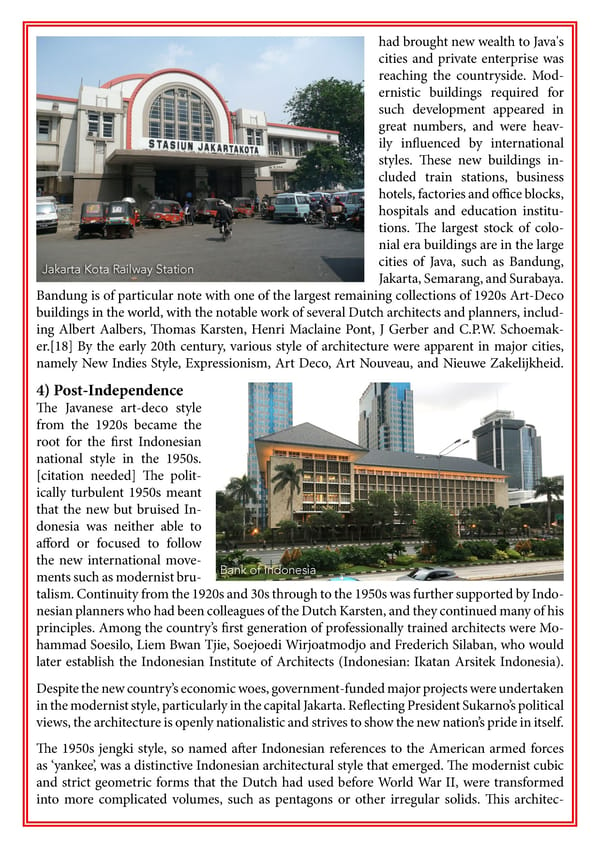had brought new wealth to Java's cities and private enterprise was reaching the countryside. Mod- ernistic buildings required for such development appeared in great numbers, and were heav- ily influenced by international styles. These new buildings in- cluded train stations, business hotels, factories and office blocks, hospitals and education institu- tions. The largest stock of colo- nial era buildings are in the large Jakarta Kota Railway Station cities of Java, such as Bandung, Jakarta, Semarang, and Surabaya. Bandung is of particular note with one of the largest remaining collections of 1920s Art-Deco buildings in the world, with the notable work of several Dutch architects and planners, includ- ing Albert Aalbers, Thomas Karsten, Henri Maclaine Pont, J Gerber and C.P.W. Schoemak- er.[18] By the early 20th century, various style of architecture were apparent in major cities, namely New Indies Style, Expressionism, Art Deco, Art Nouveau, and Nieuwe Zakelijkheid. 4) Post-Independence The Javanese art-deco style from the 1920s became the root for the first Indonesian national style in the 1950s. [citation needed] The polit- ically turbulent 1950s meant that the new but bruised In- donesia was neither able to afford or focused to follow the new international move- Bank of Indonesia ments such as modernist bru- talism. Continuity from the 1920s and 30s through to the 1950s was further supported by Indo- nesian planners who had been colleagues of the Dutch Karsten, and they continued many of his principles. Among the country’s first generation of professionally trained architects were Mo- hammad Soesilo, Liem Bwan Tjie, Soejoedi Wirjoatmodjo and Frederich Silaban, who would later establish the Indonesian Institute of Architects (Indonesian: Ikatan Arsitek Indonesia). Despite the new country’s economic woes, government-funded major projects were undertaken in the modernist style, particularly in the capital Jakarta. Reflecting President Sukarno’s political views, the architecture is openly nationalistic and strives to show the new nation’s pride in itself. The 1950s jengki style, so named after Indonesian references to the American armed forces as ‘yankee’, was a distinctive Indonesian architectural style that emerged. The modernist cubic and strict geometric forms that the Dutch had used before World War II, were transformed into more complicated volumes, such as pentagons or other irregular solids. This architec-
 Visual Guide Indonesia Page 17 Page 19
Visual Guide Indonesia Page 17 Page 19